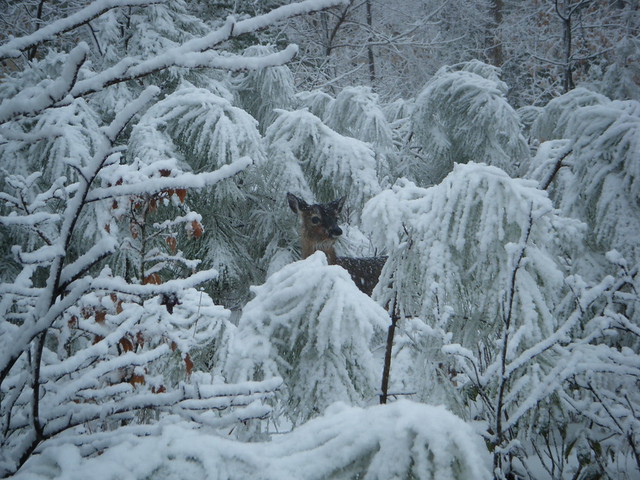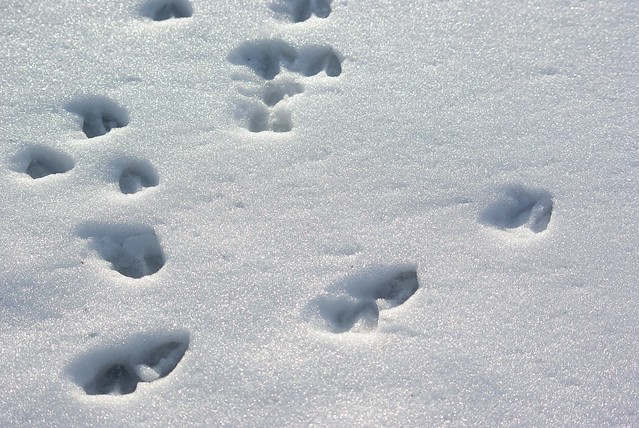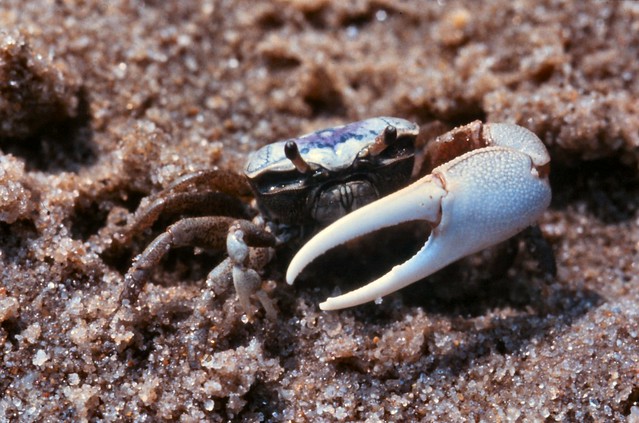Open fires are prohibited throughout the park from midnight to 4 p.m. through April 30 per the 4 p.m. Burning Law. This includes wood and charcoal. Gas is permissible. Campground fires are allowed during the restricted time if a camp host is on duty and signage to that effect is posted in the campground. Failure to observe the 4 p.m. Burning Law can result in a fine. Contact the Park Office for additional information.
Read Our Blogs
The Secret Lives of Animals In Winter Revealed!
What are animals up to in winter? Furry, feathery, and scaly...let's find out.
 Can you spot who is hiding in the snow at York River State Park?
Can you spot who is hiding in the snow at York River State Park?
Old man winter has finally shown up this year and forced us to break out our very best winter apparel. As you sit bundled up by the fire with a warm, fragrant drink, it probably doesn’t faze you that there is a secret world of organisms still out there battling those frigid temperatures. It’s a wonder that any species manage to survive year-by-year after what seems like an eternity of blizzards and single digit forecasts. But, there are enough animals that live to “tell” their tales – and what incredible tales of survival they are!
 Deer tracks in the snow reveal exactly where they have been
Deer tracks in the snow reveal exactly where they have been
So, how exactly do different animals keep warm in winter time? Where do they disappear to? And if they don’t disappear, then where exactly are they located?
Animals inadvertently invite us into their secret wintering lives through subtle clues they leave behind. With a little critical thinking, research, and dedicated photographers, the age old question “what do animals do in the winter?” is no longer a mystery. If animals could talk to you like Dr. Doolittle about their survival strategies in winter, here is what I speculate they would say.
Secret #1 revealed: “We ruffle our feathers… literally”
Proof: Insulation
Have you ever seen a tiny little song bird in the middle of winter and thought to yourself, “Woah, get a look at that fat little bird!” Surely that little bird did not stuff itself with food and gain half a pound in a matter of minutes. Rather, the bird manipulated the feathers so that the feathers rose up and made the bird look bigger. This mechanism allows little pockets of air to get trapped in between the feathers and insulate the body. Their downy feathers already keep them warm, but fluffing up their contour feathers keeps them extra warm.
 The cold never bothered them anyway at Mason Neck State Park…
The cold never bothered them anyway at Mason Neck State Park…
Mammals undergo a similar process, except with fur instead of feathers. The common mammals seen on land around winter have several different types of hair, including underfur and guard hair (the top coat you see) that protects the underfur. By raising the hairs with muscles around the follicle, more air is trapped between hairs and the animal keeps warm. They also may over eat and store a good amount of fat for a finite amount of time (depending on size) so that they can keep even warmer. Birds cannot store too much fat for too long, otherwise they are unable to fly. Having a bigger body size in the long run means that heat dissipates slower from the body, so having a little extra fat in the winter is a good thing.
Secret #2 revealed: “We get out of dodge”
Proof: Migration
Some animals will absolutely not stand the cold winter and they flee from the weather however they can. In some cases the migration is short term, like Bald Eagles that migrate a short distance from northern states to southern states with a more reliable food source. In other cases it is long term, like the arduous trips made by thousands of Monarch Butterflies, several bat species like the Little Brown Bat, and large mammals in the Rockies and Midwestern states.
There are always exceptions in nature. In the case of diadromous fishes (fishes that spend different times of their life in fresh water and salt water), migration is not synonymous with fleeing from cold weather. Rather, they migrate to more favorable conditions. Fish species like Brown Trout and Alewife (anadromous) migrate up into fresh water rivers during late winter to spawn, while American Eels (catadromous) migrate downstream into salt water to spawn. They purposefully evade unfavorable conditions to spawn and forage, so their movement is considered migration too.
 Juvenile herring spp. from a spawning event in late winter at York River State Park
Juvenile herring spp. from a spawning event in late winter at York River State Park
Secret #3 revealed: “We make ourselves at home”
Proof: Torpor
During the winter time, most animals succumb to a state of prolonged dormancy. They go into torpor, or a period of inactivity where the metabolic rate, body temperature, respiration, and heart rate are reduced to conserve energy. Hibernation is the general term for winter torpor (there are other forms of torpor), and this is what many mammals, amphibians, reptiles, arthropods, and some fishes undergo during winter. These animals find safety within their insulated dens, nest, and holes while sleeping, and are awakened occasionally based upon physiological needs.
 Fiddlers like these at First Landing State Park stay put in their burrows during winter
Fiddlers like these at First Landing State Park stay put in their burrows during winter
There are very few true hibernators, and that is confirmed by strange sightings: a stray turtle on an unusually warm day over here, lots of squirrels in your yard over there. When you think about it, true hibernation is a profound state of dormancy with no awakenings for months at a time (think about sleeping for 5 straight months!). Large mammals like Grizzly Bears are unable to truly hibernate because of the outrageously high energetic costs to make the body fully functional again, so they undergo a “winter lethargy”, or loose torpor. The largest mammal that truly hibernates is the 11 pound Marmot, followed by woodchucks, some ground squirrels, and a few bat species. Fun fact: Grizzly bears would need approximately 11,116,800 calories stored up to fully awaken again if they slept for month at a time!
Secret #4 revealed: “We grin and bear it”
Proof: Resistance, Avoidance
If all else fails, sometimes the animals just need to deal with it. In fact, most species do not migrate and thus have evolved certain behaviors, structural adaptations, and/or physiological responses to tolerate the cold. These mechanisms are categorized under techniques referred to as “avoidance” and “resistance” to the cold.
Avoidance techniques are exactly what they sound like: avoiding heat loss. Many animals have evolved specific body sizes, colors, limb lengths, insulation types, and pelage types to combat the winter. They also reduce activity, reduce body mass for lower caloric demands, induce torpor, and even modify their microclimate to more favorable conditions. Resistance techniques are also similar: generating heat to resist heat loss. This includes remaining active to generate heat, shivering, and non-shivering thermogenesis (storing brown fat, which is highly vascularized tissue with lots of energy to produce heat).
 Large body mass and stubby legs hinders heat loss for these ponies at Grayson Highlands State Park
Large body mass and stubby legs hinders heat loss for these ponies at Grayson Highlands State Park
Think of salamanders, newts, and some fishes that burrow deep within the sediment at the bottom of the water, or insects in the ground. There is less exposure to rapidly changing ambient conditions when you’re deep down in the ground so your microclimate is more consistent and favorable – avoidance. This is also seen in little rodents that create dens filled with insulation materials under masses of snow. Think of beavers and rabbits that forage throughout the winter, and have a round body shape and short limbs to hinder heat loss – resistance.
And yet there are still those crazy exceptions in the reptile and amphibian world that takes survival to the extreme. Painted Turtles and Spadefoot Toads avoid freezing by supercooling, which allows them to survive way below the freezing point of their body fluids. Or even better, the Wood Frog, which tolerates the freezing cold by simply… freezing! There are incredible clues in their body chemistry (revealed through research) which enables them to survive.
Of course, there are many more secrets of how animals survive during the winter…and some of them are absolutely mind-blowing. Animals won’t come right out and tell you though, and I guess that’s the fun of figuring it out for yourself. They’re just waiting to be discovered. For now, this mystery is *somewhat* solved.
If you'd like to discover different animals at a Virginia State Park, click here for more information, or call 1-800-933-PARK.
If you have read the article and have a question, please email nancy.heltman@dcr.virginia.gov.
Search for blogs
By Park
Categories
Cabins
Camping
Fishing
History and Culture
Other
Programs and Events
Trails
Volunteers
Water Fun
Archive
2024
2023
2022
2021
2020
2019
2018
2017
2016
2015
2014
2012














